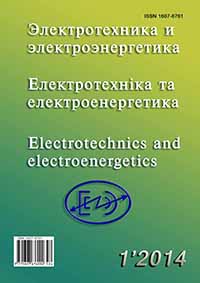DEFINITION OF DYNAMIC INDUCTANCES OF THE ASYNCHRONOUS ENGINE WITH REGARD TO PROCESSES OF SATURATION
DOI:
https://doi.org/10.15588/1607-6761-2014-1-9Keywords:
asynchronous motor, magnetization, magnetic, inductance, saturation, mathematical modelAbstract
Development of mathematical model of asynchronous machines in (d, q) coordinate system with taking into account the saturation of magnetic circuits is performed. In the paper, we used the method of dynamic inductances, which is connected with the use of a systematic study of motor properties. An analytical model of asynchronous motor magnetic circuit, which is taken into account action of the tangential and radial dynamic inductances is created. On the basis of this the sensor dynamic inductances of rich machine, which was recorded in (d, q) coordinate system of equations of rotor and stator circles of asynchronous motor with the saturation were built. The author suggests to use the method of dynamic inductances at construction of asynchronous engine mathematical model, that allows to take into account the saturation of the main magnetic path for the modes with a wide range of changes in the flow of mutual induction between the stator and the rotor, saturation flow path, the scattering modes that are characterized by large current circuits of the machine, induction, due to processes of saturation, between mutually perpendicular to the contours of the machine, as well as the joint saturation worker thread and threads scattering modes that are characterized by the significant size of the workflow and large values of currents contours of the machine. The mathematical model allows to take into account the change of the magnetic state of asynchronous motor as necessity to build adequate systems of control drives and drivingReferences
Фильц Р. В. Дифференциальные уравнения напряжений насыщенных неявнополюсных машин переменного тока / Р. В. Фильц // Известия ВУЗов. Электромеханика. – 1966. – № 11. – С. 1195–1203.
Boldea I. Induction Machines Handbook / Ion Boldea, Syed A. Nasar. – CRC Press Boca Raton : London, New York, Washington, D. C, 2002. – 845 p.
Виноградов А. Б. Векторное управление электроприводами переменного тока / А. Б. Виноградов. – ГОУВПО «Ивановский государственный энергетический университет им. В.И. Ленина». – Иваново, 2008. – 320 с.
Мищенко В. А. Теория, способы и системы векторного и оптимального векторного управления электроприводами переменного тока : монография / Мищенко В. А. – М. : Издательство «Информэлектро», 2002. – 168 с.
Пивняк Г. Г. Современные частотно-регулируемые асинхронные электроприводы с широтно-импульсной модуляцией / Г. Г. Пивняк, А. В. Волков. – Днепропетровск, 2006. – 421 с.
Кулагін Д. О. Проектування систем керування тяговими електропередачами моторвагонних поїздів : монографія / Дмитро Олександрович Кулагін. – Бердянськ : ФО-П Ткачук О. В., 2014. – 154 с.
Беспалов Б. Я. Математическая модель асинхронного двигателя в обобщенной ортогональной системе координат / Б. Я. Беспалов, Ю. А. Мощинский, А. П. Петров // Электричество. – 2002. – № 8. – С. 33–39.
Снегирев Д. А. Дифференциальные уравнения для исследования электромагнитных переходных процессов частотно-регулируемого асинхронного двигателя с учетом насыщения / Д. А. Снегирeв, А. В. Тикунов // Электротехнические комплексы и системы управления. – 2006. – № 2. – С. 69–73.
Кулагін Д. О. Спосіб апроксимації кривої намагнічування тягового асинхронного двигуна / Кулагін Д. О. // Електротехніка та електроенергетика. – 2013. – № 2. – С. 66–70.
Попович О. М. Математична модель асинхронної машини електромеханотронної системи для імітаційного та структурного моделювання / О. М. Попович // Технічна електродинаміка. – 2010. – № 4. – С. 25–32.
Попович О. М. Математична модель для розрахунку пускових характеристик асинхронного двигуна з урахуванням еквівалентних контурів втрат в сталі статора і ротора / О. М. Попович, І. В. Головань // Електротехніка і електромеханіка. – 2006. – № 1. – С. 42–46.
Downloads
How to Cite
Issue
Section
License
Copyright (c) 2017 D. O. Kulagin

This work is licensed under a Creative Commons Attribution 4.0 International License.
Creative Commons Licensing Notifications in the Copyright Notices
Authors who publish with this journal agree to the following terms:
Authors retain copyright and grant the journal right of first publication with the work simultaneously licensed under aCreative Commons Attribution License that allows others to share the work with an acknowledgement of the work's authorship and initial publication in this journal.
Authors are able to enter into separate, additional contractual arrangements for the non-exclusive distribution of the journal's published version of the work (e.g., post it to an institutional repository or publish it in a book), with an acknowledgement of its initial publication in this journal.
Authors are permitted and encouraged to post their work online (e.g., in institutional repositories or on their website) prior to and during the submission process, as it can lead to productive exchanges, as well as earlier and greater citation of published work.

